Introduction
Mobile commerce, or M-commerce, is revolutionizing the way goods and services are bought and sold, leveraging the ubiquity of smartphones and tablets to create dynamic, anytime-anywhere shopping experiences. As mobile technology advances and consumer preferences shift towards mobile-first interactions, the importance of M-commerce in today's digital marketplace cannot be overstated. Businesses are finding innovative ways to connect with customers, offering personalized and seamless shopping experiences that drive sales growth.
The interplay between online and in-store shopping is becoming increasingly crucial, with many consumers seeking consistency across channels. This trend necessitates a harmonious integration of digital and physical retail spaces, compelling retailers to adapt their strategies. The rise of mobile payments, propelled by technologies like sound wave-based transactions and the widespread adoption of smartphones, further underscores the transformative impact of M-commerce.
Despite challenges such as security concerns and data breaches, the demand for contactless payments has surged, especially in the wake of COVID-19, highlighting the sector's robust growth potential.
M-commerce is not merely about facilitating transactions; it is about enhancing the overall shopping experience. As global internet usage continues to rise, the potential customer base for M-commerce expands, presenting significant opportunities for retailers to stay competitive and meet the evolving expectations of modern shoppers.
Definition and Importance of M-Commerce
"M-commerce refers to the buying and selling of goods and services through portable devices such as smartphones and tablets.". This segment has surged in importance due to the evolution of mobile technology and the shift in consumer behavior towards mobile-first interactions. M-commerce enables companies to engage with clients at any moment and location, promoting tailored shopping interactions and boosting sales expansion in the online market.
Recent studies highlight the increasing interdependence of online and in-store purchasing activities. For example, 72% of fashion and sportswear buyers now choose to shop both online and in-store, seeking a consistent interaction across channels. Additionally, the physical sensation of touching and trying on products remains essential for over half of these shoppers, while a third visit stores to compare options. This trend underscores the necessity for retailers to integrate their digital and physical presences seamlessly.
The mobile payments industry is also experiencing significant growth, driven by the widespread adoption of technologies like sound wave-based payments and the increasing penetration of smartphones. However, security concerns and high-profile data breaches pose challenges to the industry's expansion. Despite these issues, the demand for contactless payments has surged, particularly due to COVID-19, further propelling market growth. Key players in the fragmented M-commerce market include giants like Google, IBM, Mastercard, PayPal, and Visa.
In essence, M-commerce is not just about facilitating transactions but also about enhancing the overall shopping experience. As the number of internet users continues to grow globally, with projections estimating nearly 900 million internet users in India alone by 2025, the potential customer base for M-commerce is expanding rapidly. Retailers and businesses must adapt to these trends to stay competitive and meet the evolving expectations of today's digital shoppers.
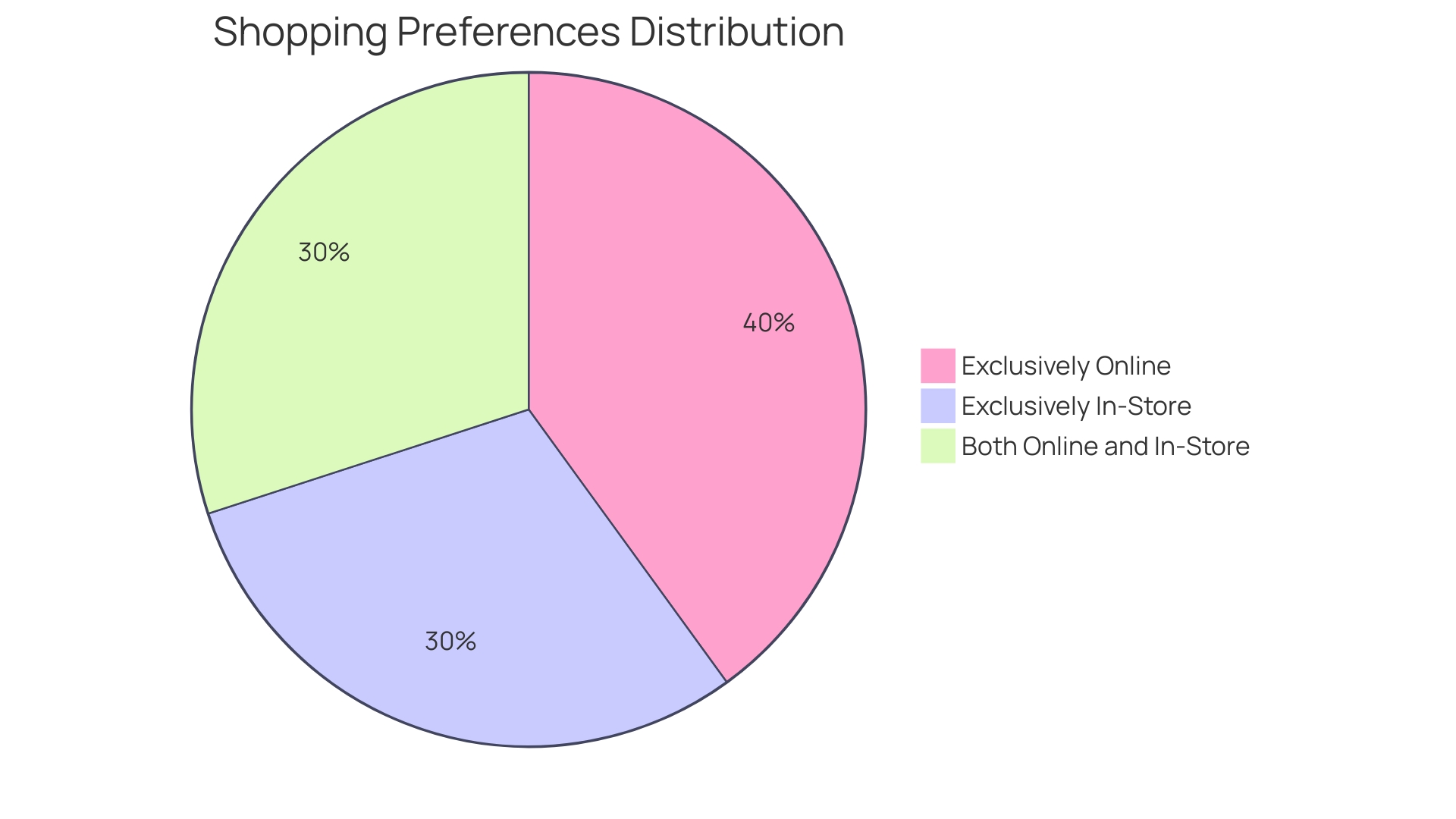
Types of M-Commerce
M-commerce can be categorized into several distinct types, each serving unique purposes and catering to various consumer needs. Understanding these types helps businesses tailor their strategies effectively to engage their target audience. One prominent type of m-commerce is cellular banking, which allows users to perform financial transactions directly from their handheld devices. Businesses such as Western Union have been utilizing wireless technology to provide smooth money transfer services worldwide, highlighting the significance of digital banking in linking individuals and enabling transactions.
Another important category is shopping via smartphones, where individuals can explore and buy products directly from their devices. 'This has gained more popularity, particularly as portable devices have become essential to individuals' lives.'. The importance of handheld gadgets in contemporary advertising is clear, with numerous shoppers favoring to purchase and engage with brands using their phones. This change in consumer behavior emphasizes the importance for companies to uphold a robust online presence.
Mobile advertising is also a crucial component of m-commerce, enabling businesses to reach their target audiences with personalized and timely advertisements. The impact of portable advertising is clear as it directly affects consumer behavior and buying choices.
Lastly, mobile apps for business operations have gained traction, providing companies with tools to manage various aspects of their operations on the go. This encompasses all aspects from inventory oversight to client relationship management, enhancing business processes to be more efficient and responsive.
By understanding and leveraging these different types of m-commerce, businesses can better position themselves in the market, engage their customers more effectively, and drive growth in the digital age.
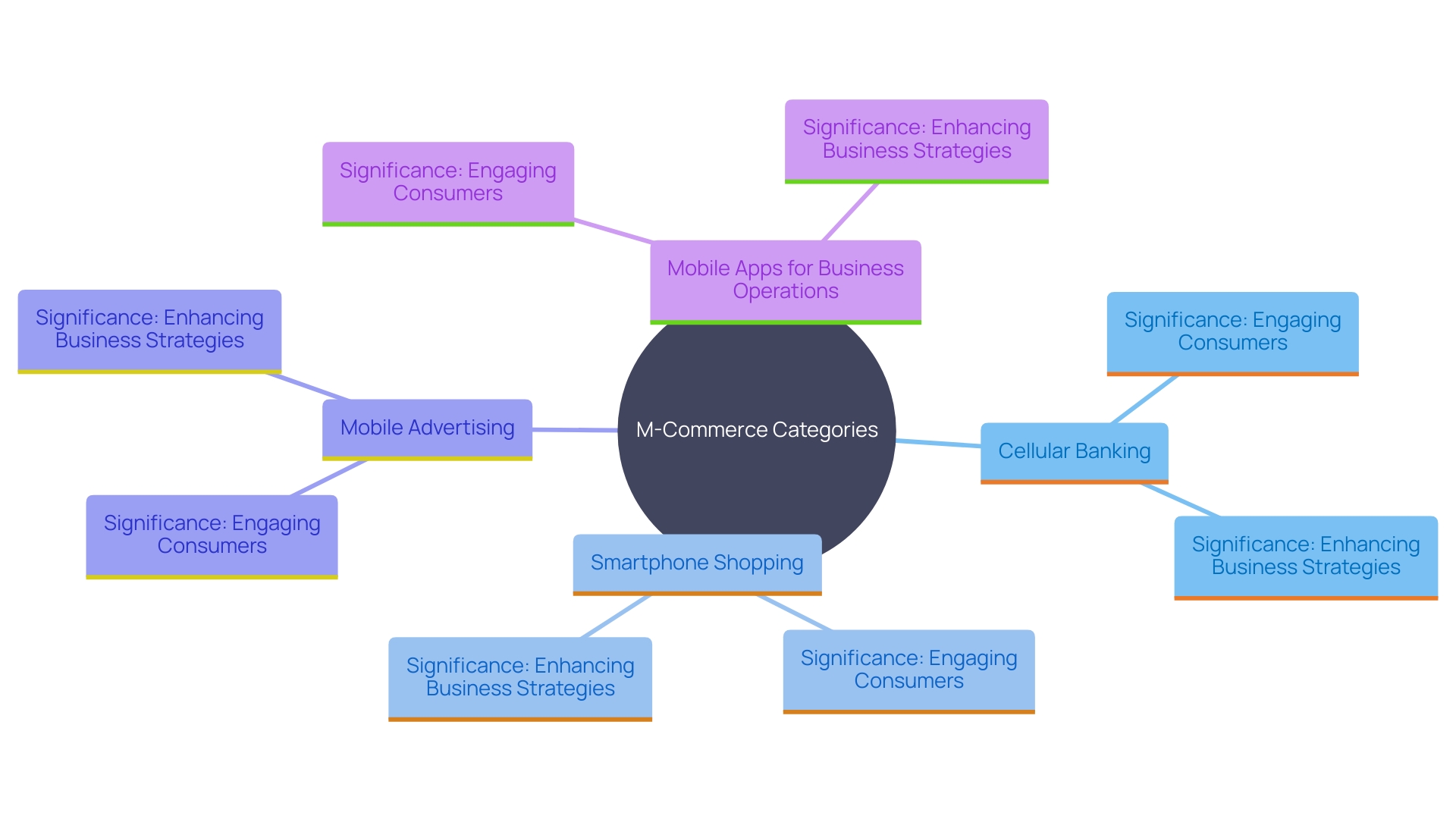
Mobile Shopping
Shopping via smartphones enables buyers to acquire goods or services directly through applications or websites tailored for portable devices. This process includes browsing catalogs, comparing prices, and executing transactions seamlessly on smartphones or tablets. Retailers have increasingly invested in mobile-friendly interfaces to enhance user satisfaction and boost conversion rates. For example, Ripley, a top retail firm in Chile and Peru, introduced an application with a user-focused strategy, intending to deliver a fast, simple, and dependable shopping process. This initiative reflects the broader industry trend of prioritizing omnichannel strategies, where the seamless integration of online and physical commerce is key. According to recent research, 72% of fashion and sportswear shoppers prefer to shop both online and in-store, highlighting the importance of a consistent experience across all channels. Retailers must align their strategies and leverage cross-functional collaboration to achieve unified commerce, as data suggests that many executives are still striving to find the right tools and technology to meet their ambitious goals.
Mobile Banking
Banking through handheld devices has transformed how individuals handle their finances, enabling them to perform a variety of transactions directly from their gadgets. This includes not only checking account balances and transferring funds but also paying bills and even managing investments. The growth of digital banking applications has greatly improved convenience and accessibility, resulting in widespread usage of banking services on smartphones.
Recent surveys suggest that over nine out of ten users have utilized some form of digital payment in the past year, a trend that has intensified during the pandemic. This shift in behavior reflects a growing trust in digital banking platforms compared to traditional banks. The incorporation of AI in smartphone banking further improves user satisfaction by offering tailored financial insights and suggestions.
As numerous users now favor mobile banking as their main way of handling finances, financial institutions are compelled to innovate consistently. The latest report on Digital Banking Maturity highlights that leaders in the industry focus on providing a comprehensive range of banking operations with seamless user experiences or developing super applications that cater to a broad spectrum of financial needs on a single platform.
The financial services landscape is evolving rapidly. Traditional banks are compelled to adapt to these changes to remain competitive, as clients increasingly expect high service quality, convenience, and low fees. This dynamic environment has led to a significant number of consumers switching their primary financial relationships in search of better offerings. Consequently, banking via smartphones is not merely a convenience but a cornerstone of contemporary financial management.
Mobile Payments
'Transactions carried out through portable devices, using digital wallets or payment applications, fall under the category of payments.'. This method revolutionizes the checkout experience by offering fast, secure payments through NFC technology or QR codes. The growth of portable payment methods is transforming buyer interactions with merchants and financial dealings. By 2026, an estimated 5.2 billion people globally will use digital wallets, highlighting a significant shift towards convenience and efficiency. The adoption of smart device payment methods also aligns with the growing demand for sustainability, allowing consumers to make environmentally conscious choices.
The convenience and speed of mobile payments are pivotal. For example, checkout-free stores in Dublin, powered by Zippin technology, enable customers to scan their payment cards to enter, and cameras and weight sensors automatically charge them for their purchases upon exit. This innovation eliminates lines and enhances the shopping experience.
The demand for cross-border transactions is also surging, with global cross-border payments projected to exceed $100 trillion within the next decade. Mobile payments provide a secure, dependable option for companies and individuals participating in international trade. 'With the digital payments market anticipated to hit $9.46 trillion in 2023, it's evident that portable payment solutions are essential for contemporary commerce.'.
Additional Forms of M-Commerce
M-commerce has evolved beyond its primary forms to include innovative applications that enhance consumer interaction and streamline transactions. For instance, Western Union has utilized mobile technology to create a seamless money transfer process, connecting people globally with just a few taps on their devices. This integration ensures families, friends, and businesses can send and receive funds effortlessly, no matter where they are.
Another example is the introduction of checkout-free stores, as seen with the new Dublin Town To Go store at Dublin Airport. Enabled by Zippin technology, this store permits individuals to scan their payment card upon entry, choose their items, and exit without waiting in line. The system uses cameras and weight sensors to automatically charge the customer's card, offering a hassle-free shopping experience that is particularly beneficial for travelers.
Furthermore, portable devices play a crucial role in contemporary marketing strategies. As consumers increasingly prefer to shop and interact with brands via their mobile devices, businesses must prioritize a strong mobile presence. This shift is supported by data from over 60 of the world's top economies, highlighting the importance of real-time, contextual, and omnichannel buying interactions.
These examples demonstrate how M-commerce is not solely focused on convenience but also on establishing secure, efficient, and engaging customer interactions. Companies like Okta are at the forefront, providing secure access from any device, ensuring that both businesses and consumers can trust the platforms they use. This emphasis on security and user experience is essential as M-commerce continues to grow and shape the future of shopping.
Social Commerce
Social commerce seamlessly merges e-commerce with social media platforms, allowing users to discover and purchase products directly through their social feeds. This innovative type of M-commerce leverages social interactions and user-generated content to drive sales, making it a crucial strategy for brands aiming to capitalize on the burgeoning social media traffic.
The growth of social commerce has been nothing short of extraordinary. According to data gathering platform Statista, it is expected to reach $1.698 trillion in sales by the end of 2024, a testament to its rapid evolution and long-term potential. This momentum indicates a significant retail opportunity that businesses cannot afford to overlook.
Brands like L’Oreal have successfully integrated social commerce into their strategy. By collaborating with a comprehensive payments partner, they were able to manage third-party money, trust and safety services, and streamline payments for customers and suppliers. This example underscores the importance of choosing a payments partner that offers a broad suite of services and has the scale to support global operations, processing nearly $10 trillion in daily global payment volume.
Additionally, social commerce is not just about transactions; it's about engaging with consumers in a space where they spend a significant amount of their time. Social advertising profoundly influences purchasing decisions, making it essential for brands to integrate seamless buying experiences within social platforms. Since the introduction of “Buy It” buttons in 2015, businesses have seen phenomenal success, from customers inquiring about products to completing orders and payments through social apps.
In conclusion, social commerce represents a transformative shift in retail, driven by the intersection of social media and e-commerce. By harnessing the power of social interactions and choosing the right strategic partners, brands can unlock substantial growth and establish a strong presence in this dynamic market.
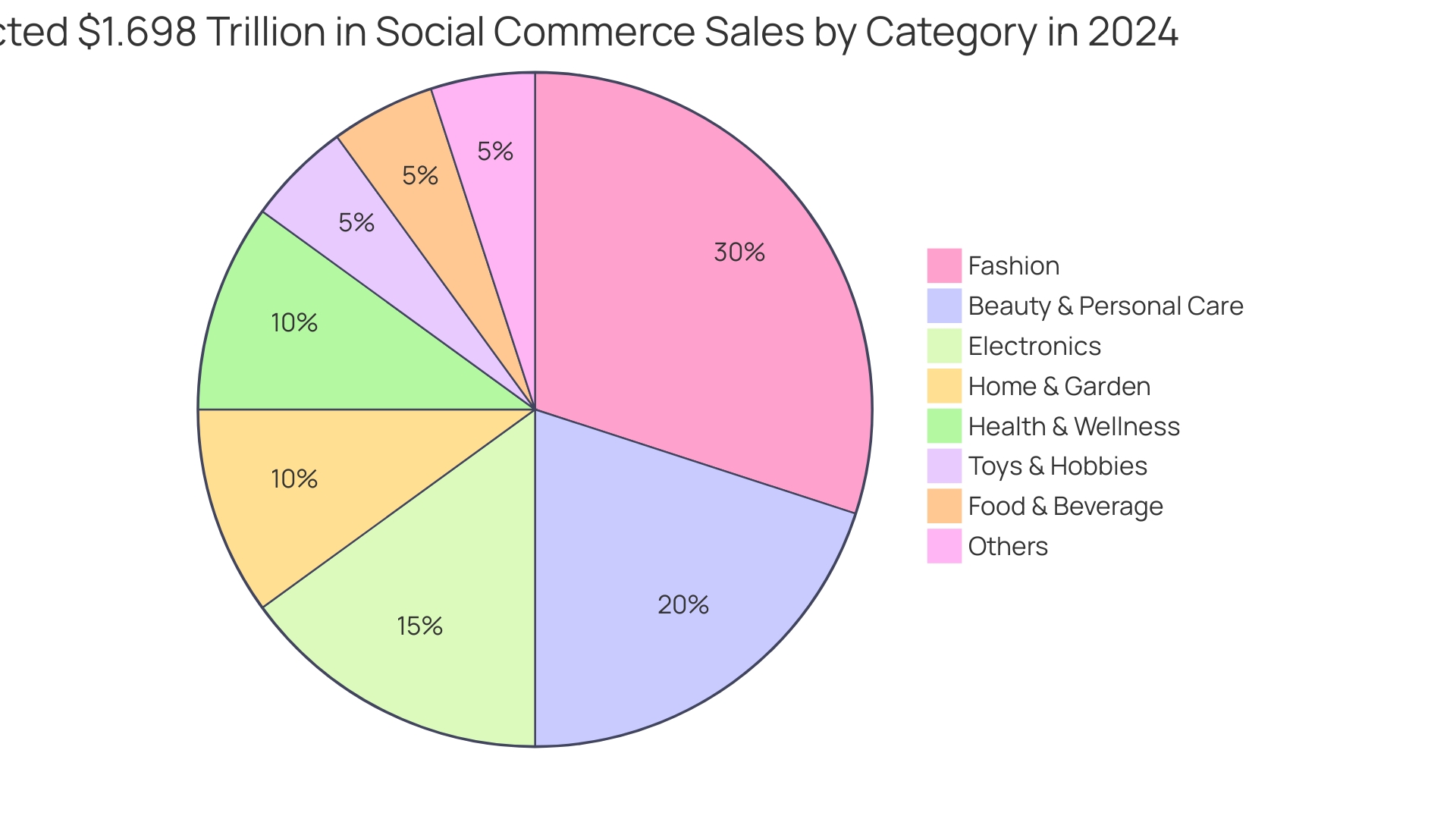
Voice Commerce
Voice commerce utilizes voice-activated assistants and devices, allowing individuals to make purchases using voice commands. The global voice commerce market has surged to $108.33 billion as of 2024, with expectations to grow at a CAGR of 27.28% until 2031. This growth is driven by the increasing prevalence of smart speakers and virtual assistants, such as Amazon's Alexa, which has sold over 500 million units since its launch. The convenience of hands-free shopping aligns perfectly with contemporary buyer preferences.
'Voice inquiries represent 20% of all Google searches, demonstrating how individuals are incorporating this technology into their everyday routines.'. A recent study by PYMNTS Intelligence revealed that 65% of U.S. consumers have used voice technology in the past year, with 21% completing a purchase via a voice assistant. This figure rises to 30% among millennials, who frequently use voice commands to pay recurring bills. The seamless integration of voice technology into commerce has transformed the shopping process, offering personalized recommendations and facilitating product research.
Businesses are increasingly adopting voice commerce to enhance client interaction. By examining voice data, companies can gain insights into user preferences, enabling them to provide customized interactions. This personalized approach is crucial, as 91% of clients are more likely to shop with businesses that customize their offerings. The adoption of voice technology is not limited by age; it is widely accepted across all demographics, with many smartphones now pre-installed with voice assistants. As this technology continues to evolve, it promises to redefine the landscape of digital shopping.
Chatbots and AI in M-Commerce
Chatbots and artificial intelligence are transforming M-commerce by greatly improving support and simplifying the shopping process. These technologies not only provide instant support and resolve queries, but they also guide users through the entire purchasing process, leading to improved engagement and satisfaction.
According to the latest research, 86% of e-commerce decision-makers plan to increase their AI investments, with 76% reporting an 11% or more boost in revenue through AI implementation. Ai's role in merchandising, search, and personalization has been particularly impactful, leading to the largest sales increases for online stores.
For instance, Benefit Cosmetics revamped their appointment scheduling process using AI-driven chatbots. Customers can now easily view, modify, or cancel their appointments within WhatsApp, enhancing convenience and reducing the burden on in-store staff. This transformation not only meets the demands of digitally savvy clients but also maintains the brand’s reputation for excellent service.
Moreover, chatbots are becoming a crucial tool for lead qualification. They gather prospective client details, background information, and educational objectives, enabling companies to customize their offers more efficiently. This capability has proven valuable across various industries, including EdTech, where 37% of chatbots provide user support in addition to collecting contacts.
In the words of Daniel Buxbaum, Head of Product, “What we’ve built in under 2.5 months, from design to production, is far from perfect. It’ll get answers wrong some of the time, just like most AI/LLMs. The vehicle comparisons are a bit dirty. The results take a while to load. It’s truly a beta; ‘v1’ of many.” This rapid advancement highlights the transformative potential of AI in enhancing digital products and user interactions in M-commerce.
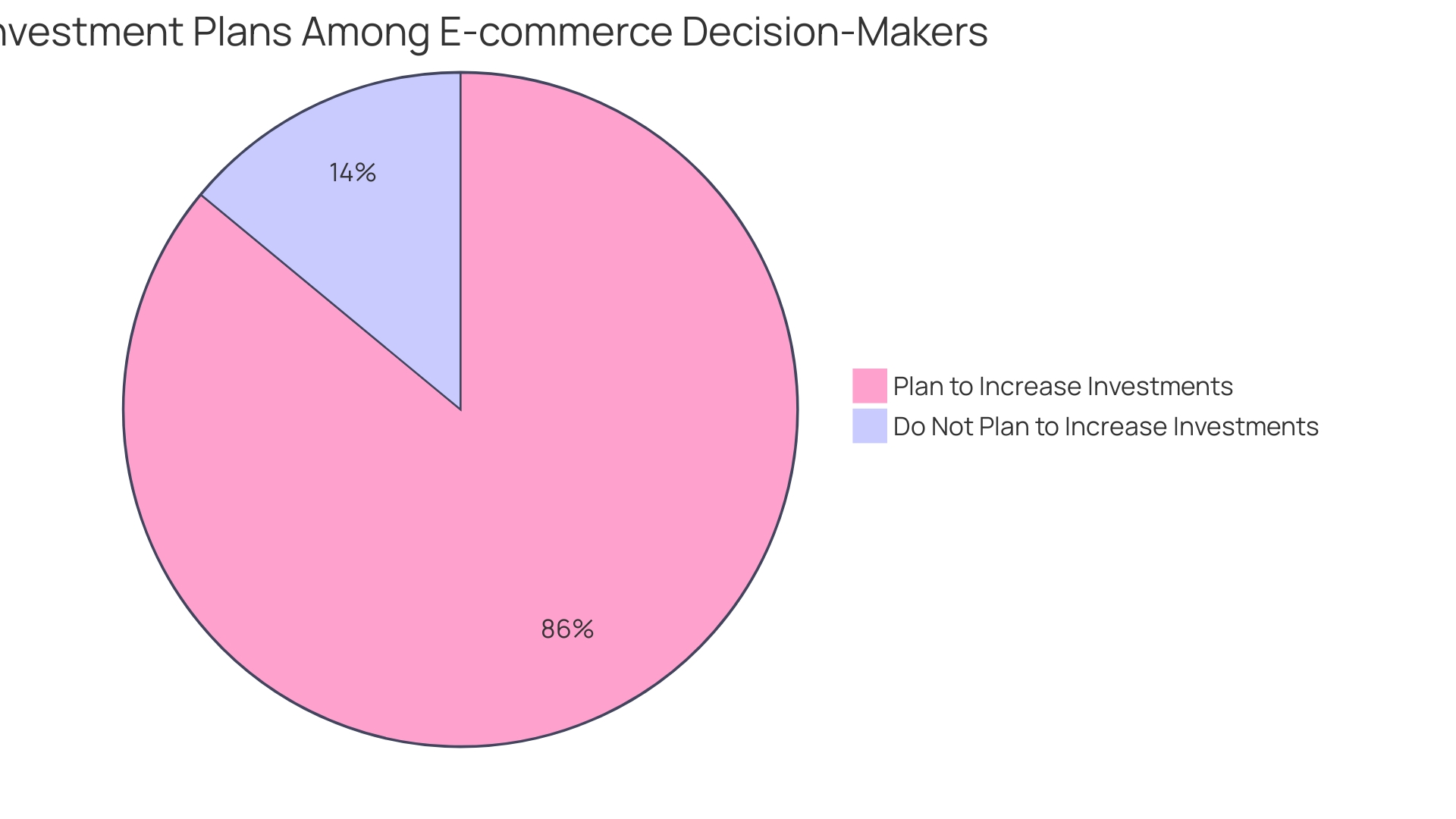
Virtual and Augmented Reality in M-Commerce
Virtual and augmented reality technologies are transforming M-commerce by providing immersive shopping encounters that are both engaging and informative. With augmented reality (AR), users can visualize products in their own environment, allowing them to make more informed purchasing decisions. This technology also enables the exploration of virtual stores, creating a seamless integration between digital and physical retail spaces.
The rise of AR technology has been especially remarkable in addressing sustainability challenges while enhancing profitability. Recent advancements indicate that AR can result in a more tailored and fulfilling interaction, which is essential for establishing enduring connections. For instance, the Dublin Town To Go store at Dublin Airport utilizes advanced AR technology to provide a checkout-free shopping process, highlighting the practical benefits and convenience for shoppers of these innovations.
As technology keeps influencing the future of retail, the emphasis on sustainability and consumer experience stays at the forefront. The adoption of AR not only fulfills customer demands for innovative shopping solutions but also aligns with the growing emphasis on eco-friendly practices. This dual benefit makes AR a powerful tool in the evolving landscape of M-commerce.
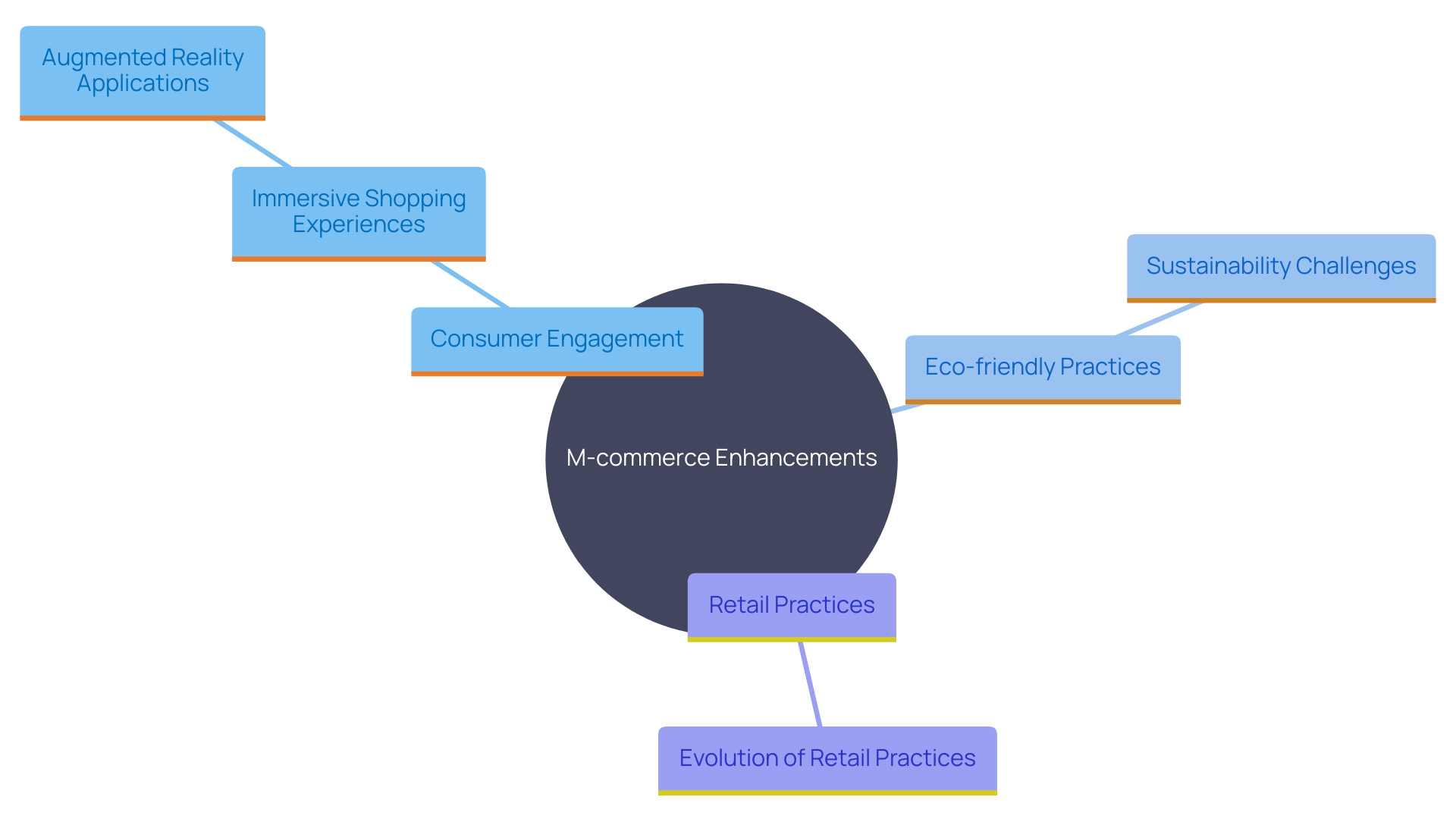
Benefits of M-Commerce
M-commerce provides substantial advantages for companies and consumers alike, including enhanced convenience, better engagement with clients, and access to a wider audience. By leveraging portable technology, businesses can execute focused marketing approaches and improve client loyalty, ultimately boosting revenue growth. For example, Bemol, a Brazilian retail chain operating in the remote Amazon region, has effectively utilized commerce through handheld devices to overcome logistical challenges and provide reliable connectivity to its customers and stores. This approach has enabled Bemol to maintain a high-performing and scalable network, essential for its retail and distribution operations. Moreover, the rise of checkout-free shops, such as the one utilizing Zippin technology at Dublin Airport, underscores the increasing significance of creative technology solutions in improving the shopping experience and addressing customer needs effectively.
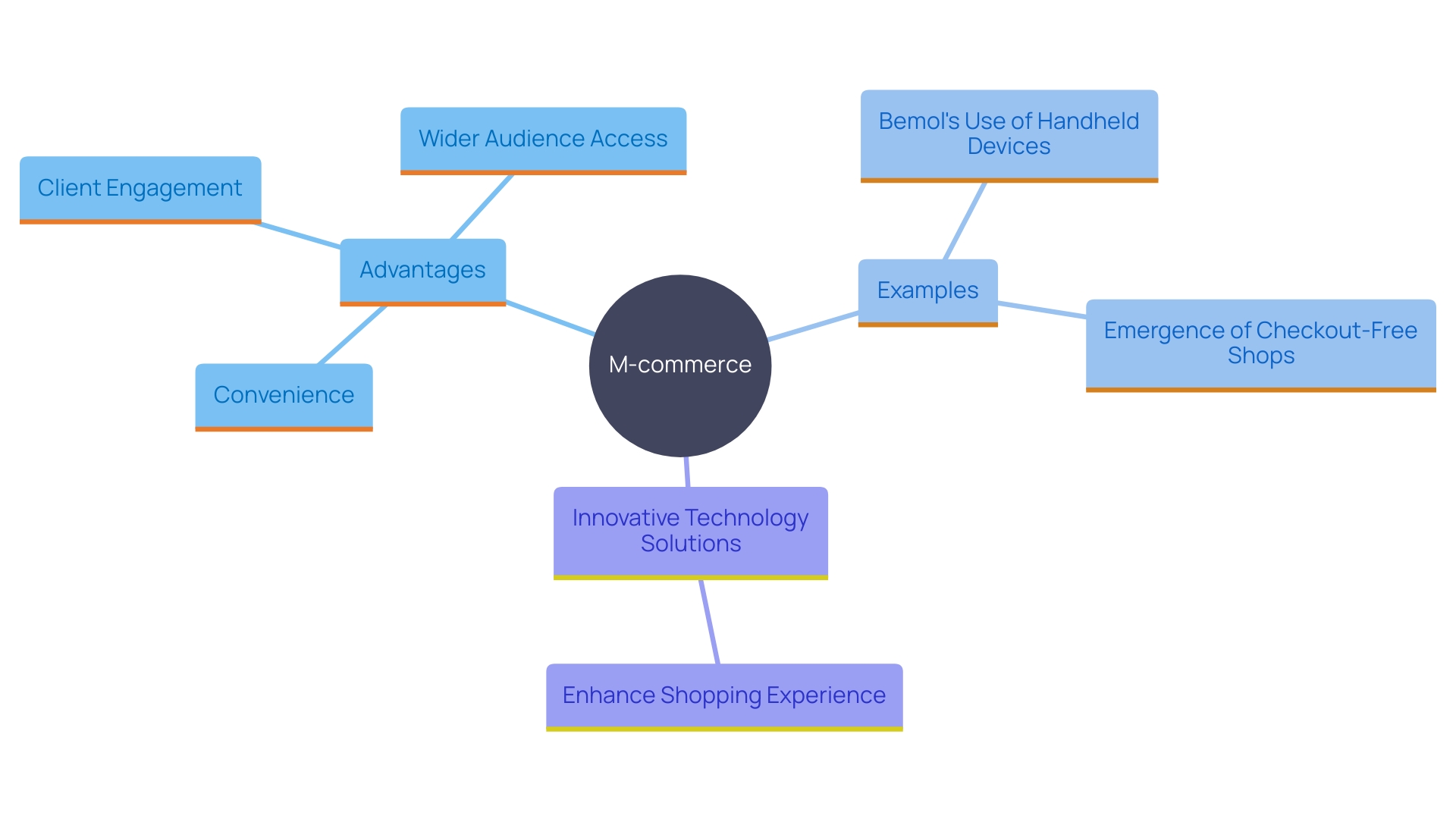
Challenges and Future of M-Commerce
'While M-commerce provides numerous advantages, it also encounters substantial obstacles such as security issues, differing device compatibility, and the necessity for ongoing technological progress.'. As portable technology evolves, businesses must adapt to these challenges to meet the changing expectations of consumers and stay competitive in the digital landscape.
For instance, the Brazilian retail chain Bemol had to overcome unique logistical challenges to provide reliable service in remote Amazon regions. By deploying a scalable and high-performing wireless network infrastructure, they ensured resilient connectivity crucial for their retail and distribution operations. This example underscores the necessity for businesses to innovate and maintain robust technological frameworks.
Moreover, the recent opening of a checkout-free store in Dublin Airport, powered by Zippin technology, highlights how businesses are leveraging advancements to enhance customer experience. 'Shoppers can now enjoy seamless, hassle-free transactions, which demonstrates the shift towards more efficient commerce solutions on devices.'.
Statistics show that mobile shopping app commerce is still lagging despite better conversion rates. This indicates that businesses need to continually improve their digital strategies to fully capitalize on the potential of M-commerce. As buyer behavior evolves, it is critical for businesses to gain insights and make informed decisions to shape their future strategies effectively.
Tim Bridges of Capgemini emphasizes that understanding these shifts in consumer behavior is essential for brands and retailers to manage and adapt to ongoing changes. By embracing technological advancements and addressing security and compatibility issues, businesses can ensure sustained growth and customer satisfaction in the dynamic world of M-commerce.
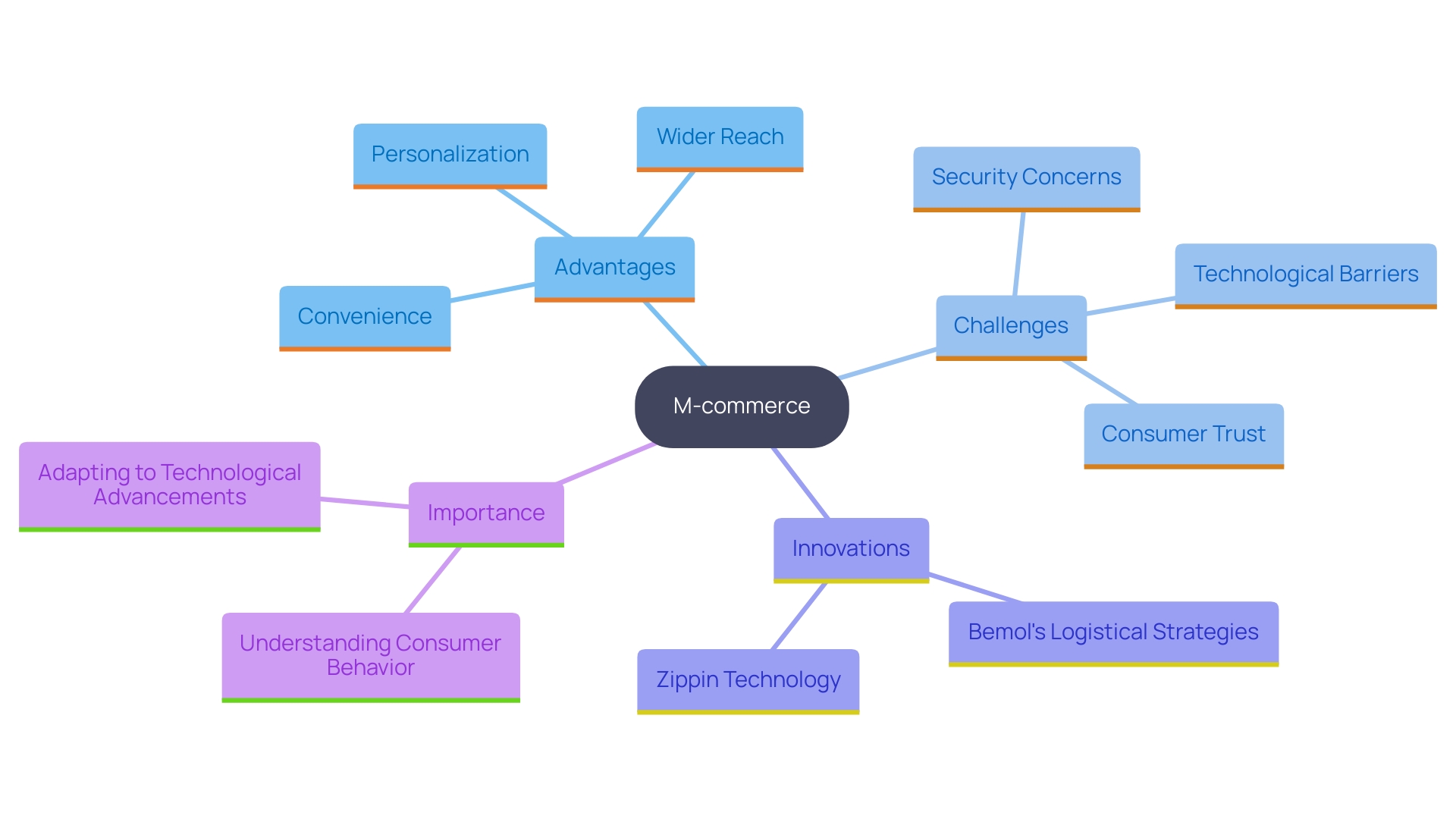
Conclusion
Mobile commerce is reshaping the retail landscape, providing businesses with unprecedented opportunities to connect with consumers through their smartphones and tablets. The integration of M-commerce into existing retail strategies is not merely optional; it has become essential for survival in a competitive marketplace. As consumers increasingly seek seamless and personalized shopping experiences, businesses must prioritize mobile-friendly solutions and omnichannel approaches to meet these expectations.
The various forms of M-commerce, including mobile shopping, banking, payments, and social commerce, highlight the diverse ways in which technology can enhance customer engagement. Innovations such as voice commerce and augmented reality are further transforming the shopping experience, making it more interactive and efficient. Retailers that leverage these technologies stand to gain a significant advantage by offering unique and convenient shopping solutions.
However, the path forward is not without challenges. Security concerns and the need for continuous technological advancements require businesses to remain vigilant and adaptive. Companies must invest in robust security measures and ensure compatibility across devices to foster consumer trust and satisfaction.
By embracing these changes and addressing potential hurdles, businesses can position themselves for sustained growth in the evolving M-commerce landscape.
In summary, the future of retail lies in the effective integration of mobile commerce strategies. By understanding consumer behavior and leveraging innovative technologies, businesses can enhance their offerings and thrive in a digital-first world. The potential for M-commerce is vast, and those who act decisively will be well-equipped to meet the demands of modern shoppers.





